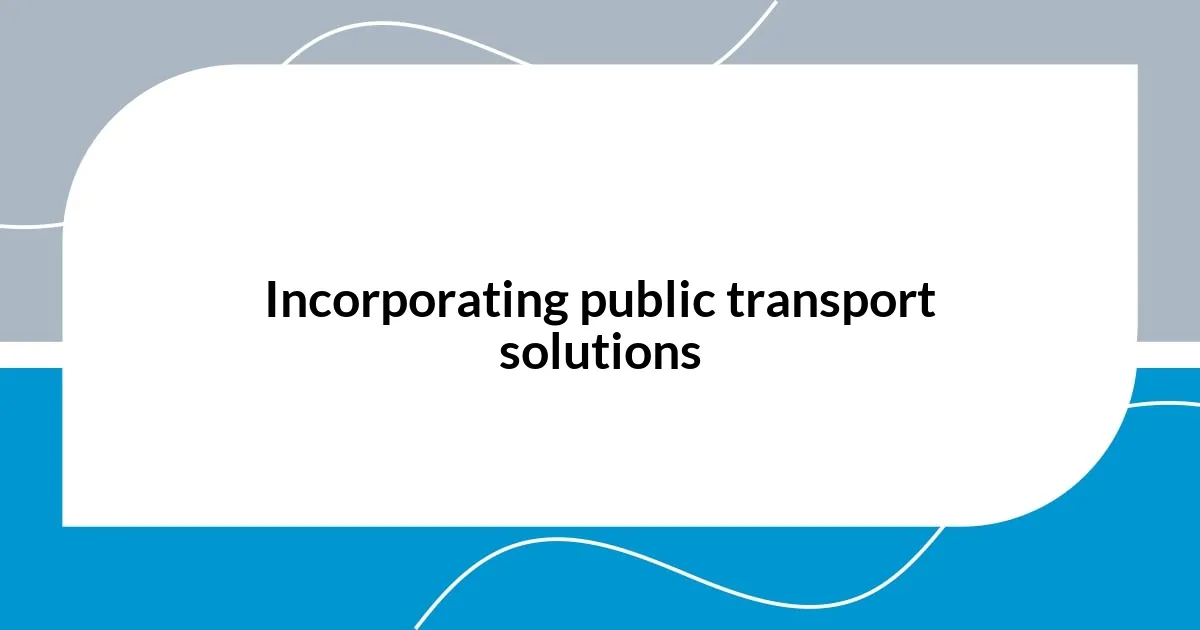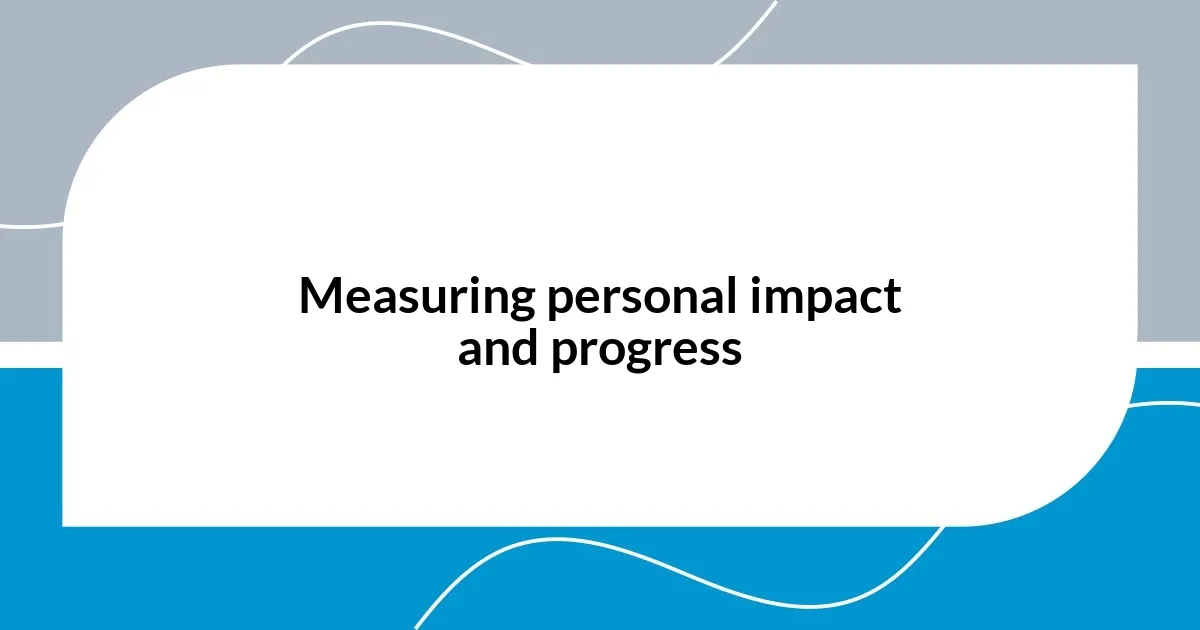Key takeaways:
- Sustainable transport enhances personal well-being and fosters community connection while reducing emissions and improving air quality.
- Choosing eco-friendly options like walking, biking, public transit, and carpooling can significantly lower individual carbon footprints and promote a sustainable lifestyle.
- Incorporating public transport increases accessibility for underserved populations, contributing to social equity and community inclusivity.
- Measuring personal impact through tracking travel choices motivates individuals to adopt sustainable practices and recognize their contributions to environmental sustainability.

Understanding sustainable transport benefits
Sustainable transport brings a multitude of benefits that go beyond just reducing emissions. I remember when I first traded my gas-guzzling car for a bicycle; not only did my carbon footprint shrink, but my mental health significantly improved. The charming sights and sounds of the world around me while pedaling added a new layer of joy to my daily commute that I never anticipated.
Think about it: when we opt for sustainable modes of transport, we’re not only making healthier choices for ourselves, but we’re also contributing to cleaner air and quieter communities. It’s striking to see how cities that prioritize public transport or bike lanes can feel so much more vibrant. Can you recall the last time you walked through a bustling city that had invested in green spaces and efficient transit? It’s almost infectious; the atmosphere pulses with a sense of community and well-being.
Beyond personal well-being, there’s the undeniable economic advantage of sustainable transport solutions. I once attended a community event that highlighted the savings municipalities could reap from investing in public transit versus road maintenance. It made me wonder: how many more resources could be directed toward schools and parks if we collectively reduced our reliance on single-occupancy vehicles? The benefits stretch far into our communities, enhancing quality of life in ways we might overlook at first glance.

Choosing eco-friendly transportation options
Choosing eco-friendly transportation options offers both practicality and a sense of connection to our environment. When I decided to use public transport more often, I discovered a newfound appreciation for the community around me. Each bus ride became an opportunity to observe the diverse tapestry of life in my city—people from all walks of life, the vibrant street art, and even the occasional street musician made my commute far more enjoyable.
When exploring eco-friendly modes, consider these options:
- Walking or Biking: Engaging with your surroundings more intimately and getting a bit of exercise.
- Public Transit: Connecting with others and saving on parking while reducing emissions.
- Carpooling: Sharing rides with friends or coworkers, fostering camaraderie and lowering overall vehicle use.
- Electric Vehicles: Enjoying the benefits of a vehicle that’s kinder to the planet while still providing convenience.
Each choice not only alters our personal commute but also contributes to a larger movement toward sustainability. I personally love the feeling of stepping off a crowded bus and breathing in the fresh, less polluted air as I walk the rest of my way home. It’s those small moments that remind me of the impact my choices can make.

Incorporating public transport solutions
Incorporating public transport solutions can transform daily commutes into meaningful experiences. Each time I hop on a train, I reflect on how this small act of leaving my car behind serves a larger purpose. I find joy in being part of a collective journey, surrounded by fellow commuters who are, like me, choosing a more sustainable path. It makes me feel connected and engaged with my community in ways I hadn’t expected.
Public transport isn’t just about getting from point A to point B; it’s about convenience and accessibility. I remember waiting for a bus during a rainstorm, and, rather than feeling frustrated, I experienced a moment of clarity. I realized that public transport helps those who might not have access to a vehicle, offering mobility to students, the elderly, and those on a budget. By prioritizing these solutions, we’re fostering inclusivity and reducing social inequalities in our cities.
Adopting a mindset that values public transport can lead to a sustainable shift in our communities. I sometimes picture the streets transformed, filled less with bumper-to-bumper traffic and more with open public spaces. Envisioning how fewer cars impact air quality and community well-being fuels my passion for advocating public transit. As more people embrace these solutions, we can create an environment where sustainable transport thrives and every journey feels like an integral part of a shared mission.
| Public Transport Options | Benefits |
|---|---|
| Bus Services | Cost-effective, accessible for many demographics |
| Subways | Fast, efficient travel through high-density areas |
| Trams | Eco-friendly, integrates into urban landscapes |

Utilizing cycling and walking strategies
Incorporating walking and cycling into my daily routine has become a source of joy and freedom. I remember the exhilaration of biking down a quiet path during a sunny afternoon, feeling the wind in my hair and the warmth of the sun on my skin. It’s hard not to smile when I spot a new café or a charming shop that I might have otherwise overlooked while driving. Have you ever felt that rush of discovery? It’s something special that cycling or walking can offer.
I’ve noticed that walking also provides a perfect opportunity for mindfulness. On those days when life feels hectic, I take a stroll through my neighborhood, absorbing the sights and sounds around me. The laughter of children playing, the rustle of leaves in the wind, and the aroma from nearby bakeries create a vivid tapestry that grounds me. Isn’t it amazing how the simple act of walking can transform our perspective on the world?
One practical approach I’ve embraced is integrating walking or cycling into my commute whenever possible. I aim to park my car further away or get off a bus stop early, turning that time into a mini workout. This practice not only reduces my carbon footprint but also keeps me feeling energized throughout the day. If more people realized how easily they could make these small adjustments, I believe they’d be surprised by the positive impact on both their health and the environment. What would it take for you to explore this option?

Adopting electric and hybrid vehicles
Adopting electric and hybrid vehicles has truly revolutionized my approach to transport, and I can’t help but feel excited about the future. When I made the switch to an electric car, the first time I took it for a drive was exhilarating. I could hardly believe how quiet it was—no engine noise, just the gentle hum of the wheels on the road—and it made me realize how peaceful driving could really be. Have you ever experienced that surprising tranquility while cruising along? It’s a game-changer.
One of the aspects I love most about my hybrid vehicle is its flexibility. I can easily switch between electric and gasoline modes depending on my needs. This versatility not only saves me money at the pump but also allows me to plan longer trips without worrying about finding a charging station. I recall a road trip I took last summer; the seamless blend of running on electric for city driving and gas for highway stretches allowed me to explore without feeling tethered to charging infrastructure. Isn’t it incredible how far technology has come to make our lives easier and greener?
What often surprises me is how adopting electric vehicles has sparked conversations with friends and family. They’re curious about my experience and often share their own concerns about sustainability. Those discussions have opened up a new dialogue about eco-friendly practices, compelling me to get more involved in promoting awareness about these transportation options. If just one of my friends decides to consider an electric vehicle after hearing my story, I believe I’ll have contributed to a positive shift in our shared responsibility toward the environment.

Implementing carpooling and ride-sharing
Implementing carpooling has been a game-changer for me and my community. I remember the first time I organized a carpool for a week-long work trip. Initially, I was surprised to see how many colleagues were eager to join—what started as a single car quickly turned into a convoy. Not only did we save on fuel costs, but we also discovered a chance to bond over our shared rides, exchanging stories and laughter that broke the monotony of our routines. Isn’t it fascinating how something as simple as sharing a commute can transform our relationships?
Ride-sharing apps have added another layer of convenience to my travel habits. I recall a rainy day when I was scrambling to reach an important meeting. Instead of stressing over parking, I decided to use a ride-sharing service. The entire experience was seamless, from requesting a ride to enjoying an interesting conversation with the driver. It made me realize how these platforms can alleviate commuting anxiety while reducing the number of cars on the road. Have you ever found yourself pleasantly surprised by the kindness of a stranger during a ride?
Moreover, I’ve seen firsthand the impact of these initiatives on our local air quality. When several of us carpool to events or share rides to work, it not only lightens the traffic but also diminishes the pollution levels in our area. Sometimes, when I’m sitting in traffic alone in my car, I can’t help but think about how many others share that same time and space, often feeling isolated. By embracing carpooling and ride-sharing, we can collectively make our journeys more enjoyable while contributing positively to our environment. Wouldn’t it be wonderful if more of us considered this approach to make our roads less congested and our air cleaner?

Measuring personal impact and progress
Tracking my personal impact and progress in sustainable transport has been an eye-opener. I recently started keeping a log of my weekly travel miles, differentiating between my electric vehicle, carpooling days, and public transport. It’s not just about numbers; each entry feels like a small victory. I find myself asking, “How can I do better next week?” and it motivates me to explore more sustainable options.
One surprising metric I’ve monitored is my carbon footprint reduction. The first time I calculated it, I was surprised to see how much I was contributing to decreasing emissions by simply switching to electric and carpooling. I remember the sense of achievement I felt when I realized I had cut my transportation-related emissions by over 40% in just a few months. Has anyone else measured their progress and felt that same rush of pride? It’s profoundly motivating to see tangible proof of our efforts toward sustainability.
I’ve also begun using apps that measure fuel savings and environmental impact. One day, I opened one of these apps after a month of dedicated commuting choices. The message, “You saved the equivalent of 100 trees this month,” truly struck me! It’s moments like these that make all the effort worthwhile. I often ponder, how many more trees can we save together? It reminds me that, beyond personal progress, our collective actions can lead to significant change.